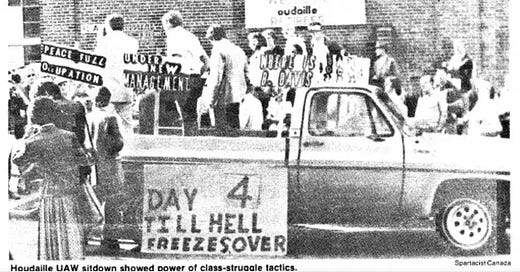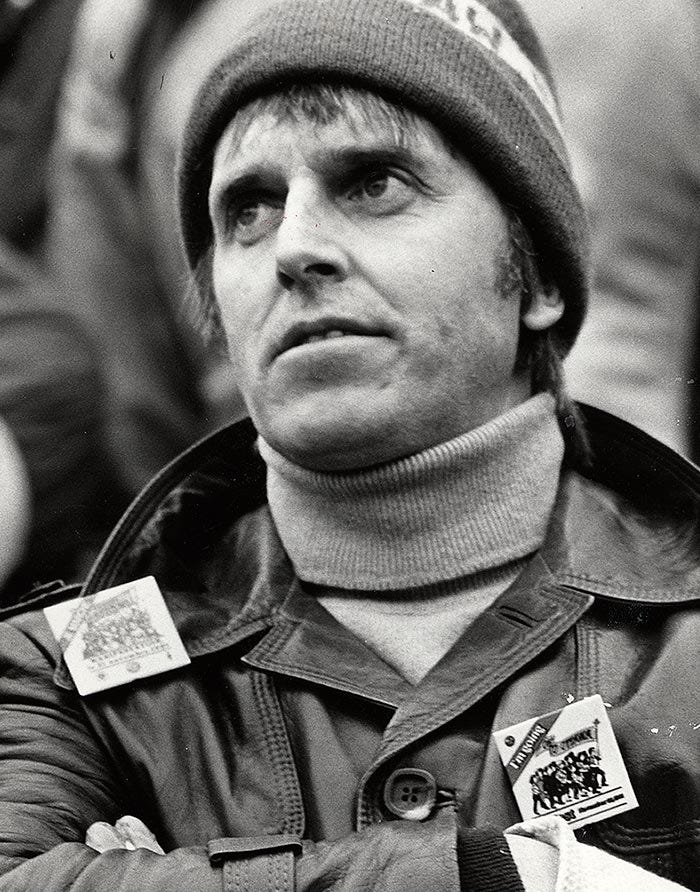I was in the autoworker town of Oshawa this past week as the latest round of Trump shenanigans played out. Oshawa is on the frontline of the tariff war and its very real consequences for Canadian workers.
This is a General Motors town. They have been building cars here since the 1930s.
What happens between Canada and the United States is being played out here with very high stakes of potential lost jobs and potential investment.
But this isn't the first time Oshawa has found itself at the centre of the economic war between Canada and the United States. The city’s history offers important lessons about resilience, resistance and what it means to resist American pressure.
Operation: Break The Working-Class
In 1980, the American working class was being decimated by a full-on attack by the government of Ronald Reagan. Federal Reserve chair Paul Volcker had driven interest rates to 13%. It led to a massive bleed-off of jobs. Volcker defended the strategy as being necessary to break the American working class.
"The standard of living of the average worker has to decline," he told Congress.
He then drove rates to an unprecedented 20% level. People stopped purchasing vehicles, appliances, and houses. Millions of jobs were on the line.
And then Ronald Reagan delivered the sucker punch.
In 1981, he fired and blacklisted 11,000 workers during the air traffic controllers strike. This was a signal for corporate America to go on a union-busting spree. It was open season on pensions, health benefits, and the advances that had come from 30 years of consistent growth of the American middle class.
While Corporate America was smashing the power of organized labour, Ronald Reagan was ripping apart decades of carefully constructed policies and regulations that protected consumers, the environment, and finance.
The symbol of the era was the junk bond raiders. They were pirate capitalists who took over established companies, stripped them of their assets, loaded the shell operations with debt and then took the profit with them.
The Houdaille Occupation
In 1980, Canada was a branch plant of the American economy. We were suffering the worst job losses since the depression.
Amidst the economic chaos, corporate raider KKR made their move.
Their target was the venerable auto parts company Houdaille Industries, with plants in Buffalo and Oshawa. KKR used junk bonds to seize control of the company, resulting in a huge profit for KKR, while Houdaille was burdened with massive debt.
What followed was a fire sale of assets that ultimately led to the company's destruction. Houdaille's branch plant operation in Canada was the first to pay the price.
Even though they had been the recent recipient of an impressive grant of taxpayers' money to ensure competitiveness, KKR management decided to shut the plant and keep the money. Further, KKR would not going to pay the severance or pension top-ups owed to the 500 Canadian workers.
The move came as Canada's manufacturing sector was bleeding thousands of jobs. And yet, the Houdaille workers, members of the United Auto Workers (UAW) Local 222, decided they would face down the new kings of smash-and-grab capitalism.
On August 18, 1980, the workers came in for the morning shift and illegally shut the factory. They blocked the plant gates and hung a banner out front that read:
DAY 1 – UNTIL HELL FREEZES OVER
Elbows Up Resistance
Bob White, the newly elected president of the Canadian wing of the UAW, was determined to resist the tactics being used to hammer their American cousins.
He went all in.
At first, the Houdaille occupation garnered little attention. Then, workers raised the stakes by announcing they would not allow the dependent automobile plants to remove parts that were needed to keep the assembly lines running.
This was a serious escalation.
Houdaille existed within a much larger and very fragile ecosystem. If those parts weren’t shipped out, the assembly lines at the Big Three could shut down. This spelled serious economic trouble not just for the workers at Chrysler, Ford, and GM but also for all the supply plants that serviced them. This was the nuclear option.
Despite the threat posed to a fragile economy, Bob White didn't blink.
No parts were coming out of the plant unless a deal was in place for the workers. And in an impressive act of solidarity, workers from across the region came out to Houdaille to make sure the plant gates remained shut.
After two weeks, the provincial Progressive Conservative government of Bill Davis stepped in on the side of the workers, announcing that KKR would be forced to pay the severances owed.
The government went further by amending Ontario's labour laws to ensure that all workers facing job loss were legally entitled to proper severance and payout.
It was a massive victory at a time of deep uncertainty.
And decades later, workers still benefit from the change in severance laws that the Houdaille activists forced.
The Houdaille occupation represents a powerful and dangerous memory of how resistance was still possible, even in the darkest of economic times.
No Concessions
And yet, the larger economic crisis remained.
As conditions deteriorated, Bob White announced a "no concessions" policy in negotiations with companies claiming economic difficulties.
Sam Gindin, an economist for the Canadian UAW, explained this to me in an interview:
"It was a dicey strategy, but we had to walk through this and defend workers. We were realistic. We knew we were going to lose some battles. With 18% interest rates, there is going to be zero cars sold, there is going to be unemployment. There will be jobs lost. We understood this, but we weren't being given an alternative that could work. If we accepted the concessions, it wouldn't stop the bleeding. The union movement would be destroyed."
The no-concessions strategy led to plant closures. It created risky showdowns between the Canadian workers and the auto giants at Chrysler and General Motors.
And it led to a growing split with the American parent union, which consistently advocated for concessions and accommodations to secure job security.
But it stabilized the Canadian union movement in a time of massive pressure.
The GM Strike of 1984
The height of the pressure came in 1984 when 36,000 Canadian workers walked off the job at General Motors in Oshawa rather than accept a lump sum payment that had been agreed to by American workers.
The business community and media denounced the Canadian workers as a threat to the economy, their own jobs, and the company's future. General Motors threatened to shut down its Canadian operations permanently.
The stakes couldn't have been higher.
But GM's threat backfired. The upstart Canadian workers began to be seen as folk heroes of resistance. An editorial even denounced GM for treating Canada as a "banana republic."
In the end, GM came back to the table and negotiated a fair settlement.
In the early 1980s, the Canadian auto workers represented a strong “elbows up" nationalism that pushed for Canadian solutions for Canadian workers. They made an enormous difference.
Canadian workers suffered grievously in the 1980s but not nearly as bad as those in the United States. Why? Because the shock doctrine was resisted through the solidarity that existed between the labour, the progressive left, and elected politicians in the New Democratic Party.
So, what were the long-term implications of the shock doctrine that hit like a hurricane in January 1980?
Consider this: in the 1970s, the unionized workforce in the United States stood at 25%, but today stands at little more than 6%. The right succeeded in pushing labour back to levels that existed in the early 1900s during the brutal "Gilded Age" of robber baron capitalism.
In Canada, on the other hand, the drop in union representation went from 31 percent in the 1970s to 28.4% in 2003. This remarkable difference between the two countries goes back to the resistance offered by the Canadian working class in the 1980s at plants like Houdaille.
If one looks at the 40-plus years of statistical data on the state of the American working class following the destruction of the labour movement, the trauma inflicted by the Reagan attack on workers in the early 1980s is easily measurable.
Across all indicators, American workers have faced a shocking level of lost opportunities. A recent study by the Rand Institute, hardly a bastion of leftwing thought, has charted the pillaging of wages from the working and middle class in America. They valued the loss of income for every worker at $1,144 per month for every year over the last four decades.
And that money went straight into the bank accounts of the 1%.
The price tag for this looting of the American working and middle class since 1980 comes in at $50 trillion in accumulated lost wages and benefits.
Oshawa teaches us the lesson that when our backs are to the wall and when we are dealing with forces that are out to drive us down, "no concessions" is the only appropriate course of action.
Oshawa workers took on the full power of Reaganomics with their "Elbows Up" resistance. And they prevailed. We will do the same today.
Oshawa workers are once again on the front lines. But the message I heard from the families in Oshawa is that they have draw a line in the sand - no concessions to Trump or MAGA.
No kissing the gangster ring.
The auto workers in Oshawa stand on the shoulders of giants. We stand with them. Elbows up. No Surrender.








Charlie gives me hope! PS I'm from the US and Charlie just gave the best breakdown of how Regan broke the US better than anyone besides Robert Reich
A true example of resistance by the little guy. Thank you, Charlie, for this incredible history lesson.